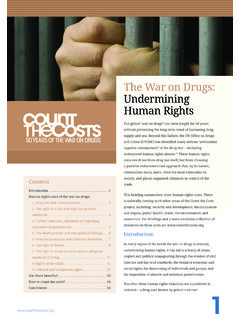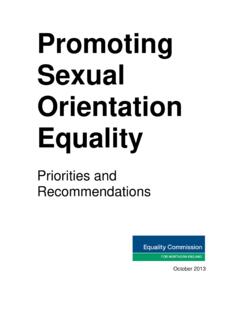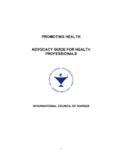Transcription of The War on Drugs: Promoting stigma and …
1 1 Criminalisation of people who use drugs 3 Media potrayals 3 Limited employment prospects and life chances 5 Reduced standards of welfare 5 Voter disenfranchisement 5 Restricted access to healthcare 5 Torture and abuse 6 Criminalisation of drug production and trafficking 7 The stigma and discrimination costs of the war on Drugs: 1 Ethnic minorities 72 Women 83 Children and young people 94 Indigenous peoples 105 people living in poverty 11 Are there benefits?
2 12 How to count the costs? 12 Conclusions 13 The War on Drugs: Promoting stigma and discriminationThe global war on drugs has been fought for 50 years, without preventing the long-term trend of increasing drug supply and use Beyond this failure, the UN Office on Drugs and Crime (UNODC) has identified many serious negative unintended consequences (1) of the drug war including the stigma and discrimination faced by a range of populations These costs are distinct from those relating to drug use, stemming as they do from the choice of a punitive enforcement-led approach that, by its nature, criminalises many users often the most vulnerable in society This briefing summarises these stigma and discrimination costs There is naturally overlap with other areas of the Count the Costs project, including.
3 Security and development, human rights, crime, the environment, and economics For briefings and a more extensive collection of resources on these costs, see www countthecosts org Introduction Despite the lack of evidence that more punitive drug laws significantly deter drug use, criminalisation remains the primary weapon in the war on drugs But using the criminal justice system to solve a public health problem has proven not only ineffective, but also socially corrosive It promotes stigmatisation and discrimination, the burden of which is largely carried by already marginalised or vulnerable populations, many of whom the policy is nominally designed to protect Discrimination is the prejudicial treatment of a person based on the group, class or category to which that person belongs It is inevitably linked to stigma , the social and practical manifestation of a distinguishing mark of social disgrace (2) Although all drug use particularly when linked with public intoxication has been associated with social disapproval, there is a striking variation in how this is expressed for different drugs and using environments While it certainly surrounds users of all illicit drugs, stigma , as defined above, can be amplified by politically manufactured moral panics around certain drugs, groups or populations stigma is also markedly less evident for users of licit drugs such as alcohol or tobacco Social and legal controls certainly exist in relation to these drugs, yet they mostly relate to certain behaviours (such as smoking in public places, or public drunkenness)
4 And are by and large desirable, helping to establish healthy societal norms that minimise potential harms However, these sanctions are of a different order to social disgrace , the severe form of public disapproval reserved for those involved with illicit drugs This disparity is not explained by differences in the effects or potential harms of drugs indeed drug harm rankings consistently rate alcohol and tobacco as equal to or more risky than many illicit drugs (3) Instead, it is the product of policies that, for historically discriminatory reasons, have created parallel and dramatically divergent control regimes for comparable substances Some explanation can be traced to the xenophobic social climate in the US during the 19th and early 20th centuries The emergence of laws criminalising certain drugs was significantly associated with immigrant populations perceived to be the most prolific consumers Chinese users of opium,(4) African Americans users of cocaine,(5)
5 And Hispanic users of marijuana The cultural and legal association of these drugs with otherness and deviance, as distinct from alcohol and tobacco, continues to this day The 1961 UN Single Convention on Narcotic Drugs the founding legal instrument of the war on drugs refers to drug addiction as a serious evil for the individual , and a threat which the international community has a duty to combat because it is fraught with social and economic danger to mankind (6) The use of such language appears to be specifically intended as stigmatising, creating the mark of social disgrace by presenting addicts as a threat to society In this context, the narrative of unintended consequences argued by the UNODC begins to unravel The absence of alcohol and tobacco from such international controls again highlights the arbitrary moral distinctions they propagate Indeed, while tobacco is associated with a level of addiction and health harms that eclipse all other drugs legal and illegal combined, it is nonetheless subject to its own UN convention The Framework Convention on Tobacco Control has a comparable number of state signatories to the three prohibitionist drug conventions, but contains none of the stigmatising language, and by contrast to the 1961 Single Convention, outlines a series of legal.
6 Market control measures not punitive prohibitions for the non-medical use of a high-risk drug The arbitrary moral distinction between good and bad psychoactive substances, and the prohibitions established as a result of this distinction, are in themselves a form of discrimination Through criminalisation, the war on drugs compounds the stigma and discrimination experienced by people who use drugs3 Criminalisation of people who use drugsAs with other criminalised behaviours, drug use (or the criminalisation of possession, which in practice amounts to the same thing) and in particular drug dependence, is taken by many to be an indicator of certain objectionable character traits or dissolute lifestyle choices Indeed, across a number of countries, drug addiction is the most strongly stigmatised of a range of health and social conditions, including homelessness, leprosy, being dirty or unkempt, and possessing a criminal record for burglary (7)
7 This stigma has a range of knock-on effects, all of which further marginalise and threaten the wellbeing of people who use drugs The relationship between criminalisation, stigma and discrimination is undoubtedly complex While criminalisation is an inherently stigmatising process that often leads to discrimination, it is discrimination at wider social and political levels that initiates this process Many affected populations will experience multiple types of discrimination a young black male living in a socially deprived US urban environment, for example The criminalisation implicit in the war on drugs will tend to exacerbate existing inequalities especially where other forms of discrimination exist people who use drugs can be stigmatised or discriminated against irrespective of whether they have received a criminal record for their use However, criminalisation exacerbates this stigma and discrimination, as there is an inevitable link between the labelling of an individual as a criminal and how they are perceived and treated by the rest of society Indeed, as well as the potential sentence itself, the negative associations of criminalisation are intended to have a deterrent effect for others In the case of drugs, although criminalisation does not significantly deter use,(8)
8 The negative associations can remain for years, often for life Media portrayalsPublic antipathy towards people who use or are dependent on drugs is fuelled or at least echoed and amplified by inaccurate or offensive media reporting While it is now rightly considered unacceptable to describe someone with mental health problems as a psycho or lunatic , equivalently stigmatising language still persists in media descriptions of people who use drugs Terms such as junkie , or clean/dirty (to describe drug users), are widely used essentially as bywords for social deviance Their effect is to dehumanise, implying that a person s drug use is the defining feature of their character Dependent drug users are one of the few populations that media commentators can still insult and demean with a large degree of impunity Media coverage of drug-related deaths also reinforces the discriminatory distinction between good and bad drugs and drug users So, while fatalities resulting from alcohol or prescription drugs go largely unreported, illegal drug deaths receive significant press attention Considering poisoning The fifth unintended consequence [of international drug control] is the way we perceive and deal with the users of illicit drugs.
9 A system appears to have been created in which those who fall into the web of addiction find themselves excluded and marginalized from the social mainstream, tainted with a moral stigma , and often unable to find treatment even when they may be motivated to want it. United Nations Office on Drugs and Crime2008 World Drug Reportdeaths in the UK in 2008 for example, 2% were reported in the popular media for alcohol and methadone, compared to 9% for heroin/morphine, 66% for cocaine, and 106% for ecstasy (i e more deaths were reported than actually occurred) (9)Once identified as an illicit drug user by the media, the label can be hard to escape News reports often reinforce and perpetuate the stigma of drug dependence, as the subject of an article can be referred to as a former drug addict even when the relevance of this information to the story is highly questionable If every junkie in this country were to die tomorrow I would cheer On 18th February 2011 the Irish Independent published a column by Ian O Doherty entitled Sterilising junkies may seem harsh, but it does make sense In it, he described people who use drugs as vermin and as feral, worthless scumbags He also wrote: Let s get a few things straight I hate junkies more than anything else.
10 I hate their greed, their stupidity, their constant sense of self-pity, the way they can justify their behaviour, the damage they do to their own family and to others. He added that: If every junkie in this country were to die tomorrow I would cheer. A complaint about the column made to the Irish Press Ombudsman was later upheld, finding that the newspaper, breached Principle 8 (Prejudice) of the Code of Practice for Newspapers and Magazines because it was likely to cause grave offence to or stir up hatred against individuals or groups addicted to drugs on the basis of their illness. This was a landmark ruling, according to the complainants: We believe this to be the first time that drug users have been identified by a media watchdog as an identifiable group, entitled to protections against hate-type speech in the press. In this sense, we think the decision of the Press Ombudsman has international significance.








